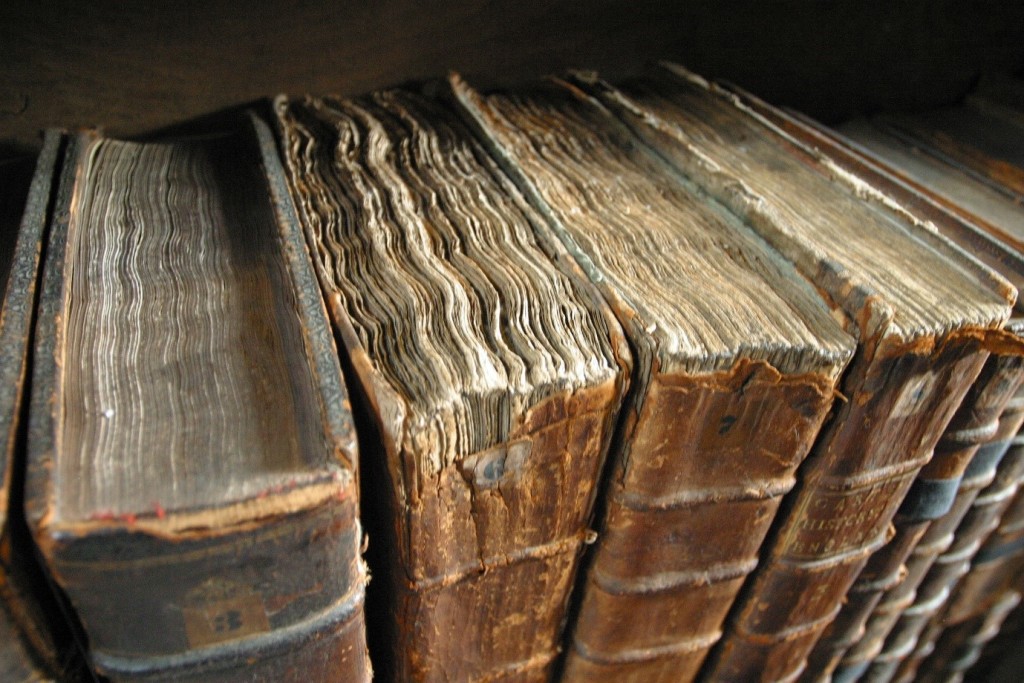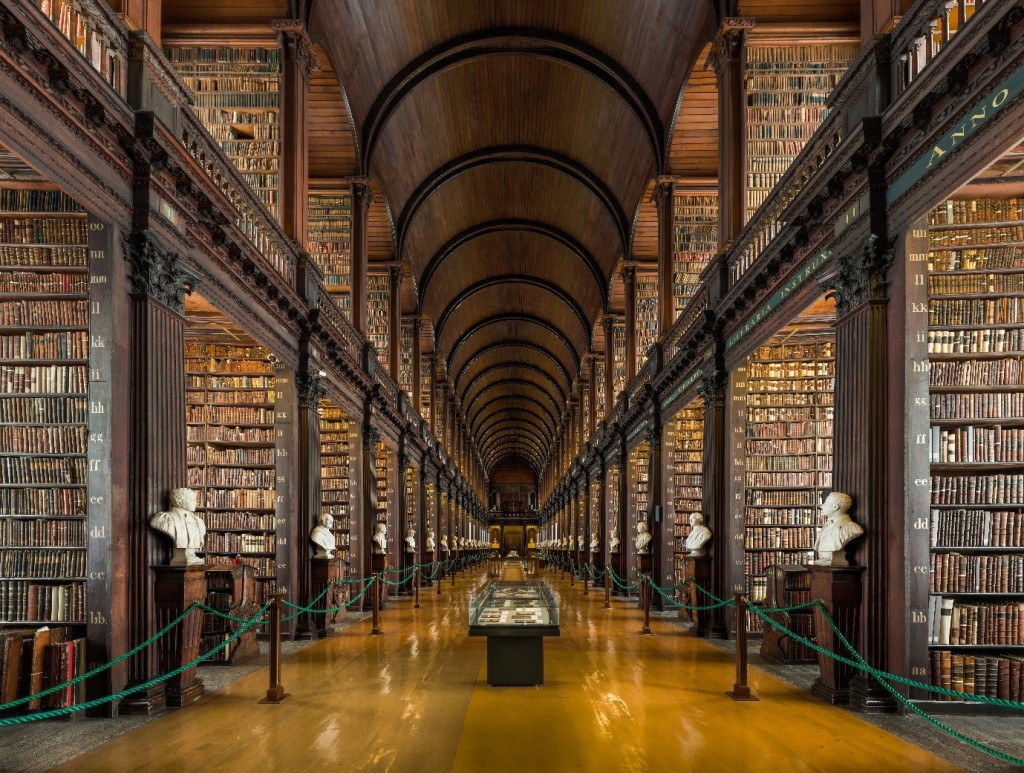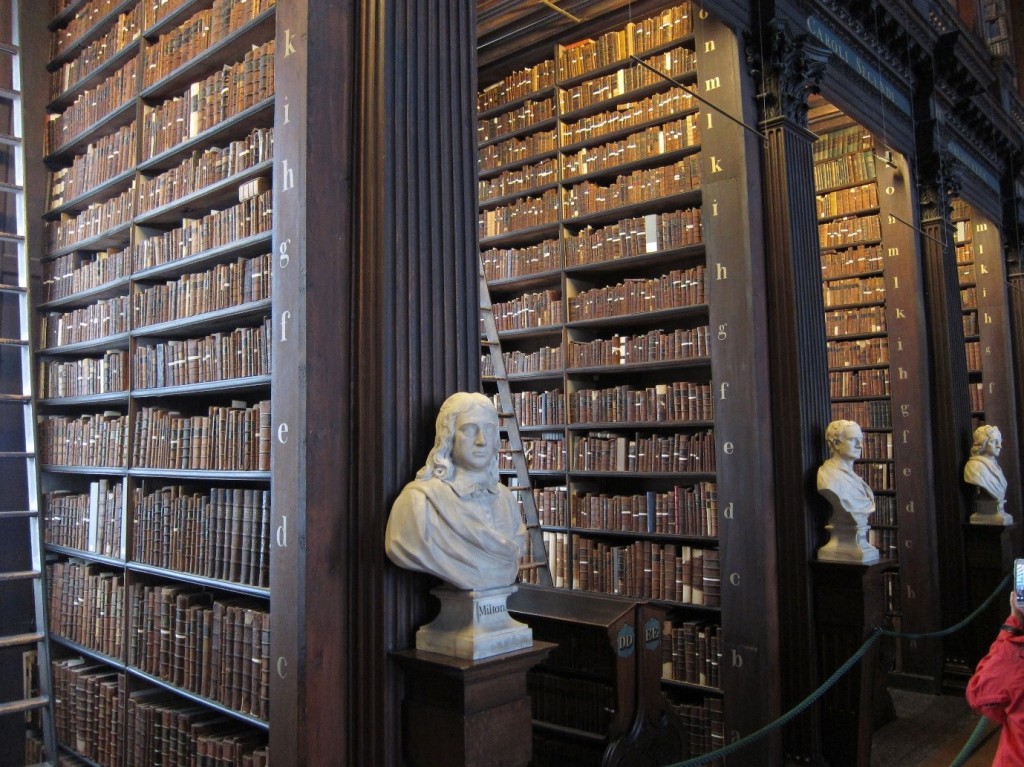Written by Sinead

Image by Tom Murphy VII, CC BY-SA 3, via Wikimedia Commons
I have always had an interest in old books, specifically beautifully illustrated, leather-bound books with interesting topics from a bygone era. I remember buying a second-hand book when I was about nine years old and being absolutely fascinated by the copperplate inscription inside the front cover. The book was a school prize for English prose won by a boy in the 19th century. It listed the other prizes too, but what really caught my attention when I was a little girl, was the inscription written over 100 years before in around 1880. With its cobalt blue cover with gilt decorated spine and fore-edge, it was not like any book I was used to handling in the 1980s. It had stunning black-and-white printed illustrations which reflected the title of the book which was a story about a boy going to work on a great merchant ship. The book seemed to me to be a thing of great wonder and beauty, so I brought it into school to show my teacher and class what I believed to be a fascinating relic from the past. Many years later, my hunger for the printed word manifested in a small, but growing collection of early printed W. B. Yeats books. This was to be the beginning of my adventure into the world of old books.
The wheel of fortune spun in my favour in 2009 when an opportunity was advertised to work as a Preservation Assistant in the Long Room with Trinity College’s Conservation Department, this being the department responsible for the care and protection of one of Ireland’s most famous treasures – the Book of Kells. It was a twelve-month internship and I became a member of a small team tasked to work on the Old Library Preservation Project. The work of the project consisted of the documentation, surface cleaning, and minor repair of the bindings and text-blocks of the Early Printed Book (EPB) collection in the Long Room. This collection of some 220,000 books ranged in date from the dawn of the printed press in the 1450s to the end of the Victorian era. This systematic preservation project was part of the ‘Save the Treasures of the Long Room’ which has been running in Trinity College Library since 2004. The purpose of the project is to deal with the problems and challenges caused by the age and handling of the books, as well as other environmental factors such as the huge numbers of visitors to the building. As a Preservation Assistant, the cleaning of the books and recording of data was an important part of this long-term project.

Image by Diliff, CC BY-SA 4.0 via Wikimedia Commons
The first time you walk into the Long Room is an awesome, jaw-dropping experience. The architecture, light and smell of the old books takes your breath away. The room has been the inspiration of popular culture, including the Jedi Library in Star Wars: Episode II – Attack of the Clones. One of the first things I noticed as I walked around the Long Room was the very tall, narrow wooden library step ladders – I knew I would one day (indeed every day) have to climb them. They looked quite intimidating to say the least! The books visible on the high wooden shelves beside the very tall, elegant windows were beautiful early printed books. They were bound in brown leather and were generally very heavy and very large in size. Some books were so large that they needed two of us to carry them to the trolley and lift onto our workspace.
Our team of four was responsible for books on the upper gallery and it mostly consisted of 19th century books and magazines, but it also had some of these early printed books. Each book required different skills in order to preserve them. These 19th century books could range from the very detailed yet impressively illustrated medical/surgical books to much smaller eye-catching works of fiction. The novels usually boasted vivid covers, much like the first book I bought as a child. The quality of the paper varied too – early books had high quality paper, compared to the much cheaper, flimsy paper of the novels. Up until the 19th century, book bindings were unique and handmade and could be made from sheepskin, calfskin or even goatskin, which was the most expensive of the leathers used. Elaborate gold-tooling on the bindings is not cheap, so a handmade book boasting this fine decoration reflects the status of the owner.
As Preservation Assistants, we received in-house training by professional conservators from the Conservation Department. We were shown all the different processes used by staff in the Conservation Laboratory, and they instructed us on the skills we would need to employ on a day-today basis in the Long Room. They also showed us the books and archival papers they were working on, some of which were being prepared for the many exhibitions which were to be on display to visitors in the Long Room.
We were provided with a special ‘Preservation Assistant’ apron, a white lab jacket, blue nitrile gloves and a mask. We were also given the use of a tool roll with special conservation tools; each item with its own particular purpose. Tools included soft dusting brushes, specialist sponge erasers (smoke sponge), unbleached cotton twill tape for keeping books stable, tweezers, a blade for cutting Japanese paper or leather, Klucel G consolidant (for flaking, degrading leather), magnifying glass (for tiny print), a soft pencil (never a pen!), Teflon bone folder (useful for lots of jobs, but not actually made from bone), a ruler, a book binders awl, and other items too many to mention. We also made up our own specialist adhesive from wheat starch paste every morning. We looked quite like the Ghostbusters some days, as we had to carry a mobile vacuum cleaner (a vac-pack) on our backs, so combined with the rest of the equipment, anyone might think we were there to clear out any library ghosts! The vacuum cleaner was fitted with specialist filters and was used for the removal of dirt from books and shelves. Cleaning was done over a low-pressure vacuum table situated at one end of the gallery. Our office? That was the best part of the job! Our workspace was located between two plaster/marble busts overlooking the full length of the Long Room! We could watch visitors as they passed, including meeting some very famous names such as Kofi Annan and Mary Robinson. No two days were the same and you never knew who you were going meet during the year.

Pdiedio, CC BY-SA 4.0, via Wikimedia Commons
The physical condition of the collection housed in the Long Room was as a result of many factors. The deterioration and damage was mainly due to the fact that these items were stored in a heritage building, meaning that the books were sitting in situ on the shelves from the time of their acquisition from the 1730s onwards. Situated in the centre of Dublin city, the collection has been subject to the pollution, dust and the humidity of the library building. The fact that the Long Room attracts huge numbers of visitors means that these pollutants are introduced from outside into the library environment accelerating this deterioration process. As it is still a working library, items are still in use by readers and handled on a daily basis. As Preservation Assistants, we carried out minimal and reversible stabilising repairs in order that the books could continue to be handled safely by both staff and readers into the future.
The Trinity College Conservation Department trained us in skills such as the consolidation of flaking and lifting leather; the reattachment of loose of detached spine pieces and end-bands; toned paper in-fills; and the treatment of paper tears. We also cleaned and re-lined library shelves, re-shelved the treated collection, and made phase boxes, book shoes, and folders for selected items from archival materials. Our daily tasks included recording key information about each book we worked with on a database, such as where and when it was printed (it wasn’t long before I quickly learned to read Roman numerals), the dimensions of the item, the materials from which it was made, bindings, or any other features of the bindings. We also recorded the treatments we carried out.
The job was not exclusively about the preservation of the collection; there was also an element of interaction with the public on general information about the Old Library collection and collection care. Later in the year I was interviewed by Lyric FM about the ‘Save the Treasures of the Long Room’ preservation project and my experience as a Preservation Assistant there. I was also given the opportunity to be involved in a boxing project with the Manuscripts Department, where I was given the chance to handle a collection of very early Irish books. This gave me the chance to work with archivists and conservators and to see the books that were being safely housed in archival standard boxes. It gave me great insight into the work of other experts in a similar field.
Working as a member of the Preservation Team at Trinity College was a wonderful opportunity to learn so much from many talented people from a variety of departments. Every day was a gift and you never knew who you could meet or what type of item you would remove from the shelves – it could be a collection of 19th century magazines, a very early beautifully illustrated oversized atlas, or a set of books in Latin. Each book required its own unique treatment and seeing how wonderful these texts could be after the dust and dirt was removed was really satisfying.

Image Jukka from HELSINKI, Finland, CC BY 2.0, via Wikimedia Commons
I met wonderful members of staff from Conservation, Bookbinding, Manuscripts, Early Printed Books, Security and Retail. I learned so much from these talented people and my experience there fuelled my passion for working with books and people. This library experience provided me with the perfect foundation to continue my dream to work with books and I am very proud to be working as a Senior Library Assistant with Offaly Libraries today. My early interest in handling old books and my thirst for knowledge inspired and motivated me to work in this area, and this involvement in the Old Library Preservation Project at Trinity College served to propel me in my pursuit of my career in public libraries. Working with early printed books and working alongside library professionals ensured that this enduring passion would continue for many years to come. My background in Trinity College has given me a whole new appreciation for local studies and the treasures that can be found in public libraries. A wealth of knowledge about the history of local areas and about local people can be found there, and in some cases, cannot be found anywhere else. If you have not yet explored the riches that are available in your local library, why not contact Offaly Library staff and discover something new about your local community!

Macregol Gospel Facsimile at Birr Library: photo by Offaly Libraries
Did you know that Offaly has its own great treasures? The Book of Birr, also known as the Macregol Gospels or the Rushworth Gospels is housed in the Bodleian Library in Oxford. Dating from the early 9th century, this beautifully illuminated early medieval manuscript of the Four Gospels, was created in Birr by the scribe and abbot of the monastery, Macregol. It was written in both Latin with added glosses in Old English. A facsimile of this great work is on permanent display free of charge courtesy of the Birr Historical Society in the magnificently restored Pugin-designed building that is now Birr Civic Offices and Library.

Birr Library: photo by Offaly Libraries
By preserving the unique and original materials in our public library’s special collections, we are guaranteeing the safekeeping and continuation of our cultural heritage. Archives and special collections are a unique record of our intellectual contribution to our local and national culture and heritage. By collecting, managing and preserving these records, and using the latest technologies, libraries are committed to ensure that these records are easily available to all library users, whilst also ensuring that this legacy will still be accessible for many generations to come.
Offaly Libraries Local Studies Service promotes and preserves Offaly’s rich history, heritage, and culture. Its collection covers the social, economic, geographic and political breadth of the county, and supports researchers in their interests. Local Studies is located in Tullamore Library, although every branch has a local studies collection.
Information about the Offaly Libraries Local Studies Collection can be found here:
https://www.offaly.ie/eng/Services/Libraries/Local-Studies/
Offaly Archives is the jointly managed archives service of Offaly County Library and Offaly Historical and Archaeological Society (Offaly History). Collections in the care of both repositories are housed in this facility, providing a comprehensive service for users of archives. Our documentary heritage is the archival memory of the community and Offaly Archives endeavours to identify, preserve and make these materials available for research purposes.
Offaly Archives is located in the Offaly Archives Unit 1F, Axis Business Park Clara Road Tullamore Co Offaly. Access to the reading room is by confirmed appointment only.
Email: archivist@offalyhistory.com
Website: www.offalyarchives.com
Image by www.offalyarchives.com

Image courtesy of http://www.offalyarchives.com
Note: At time of posting, due to current Government restrictions for Covid-19, our library buildings are not open to the public. Offaly Libraries continues to offer online services and we look forward to welcoming our patrons back into the library when circumstances allow.


